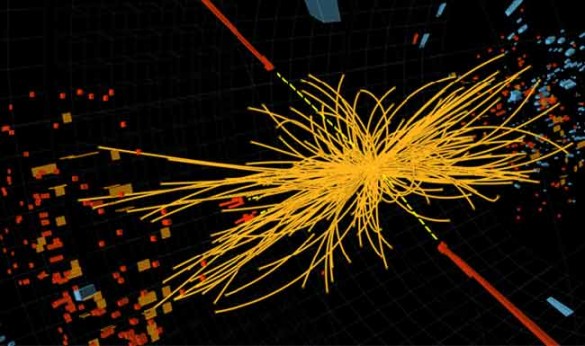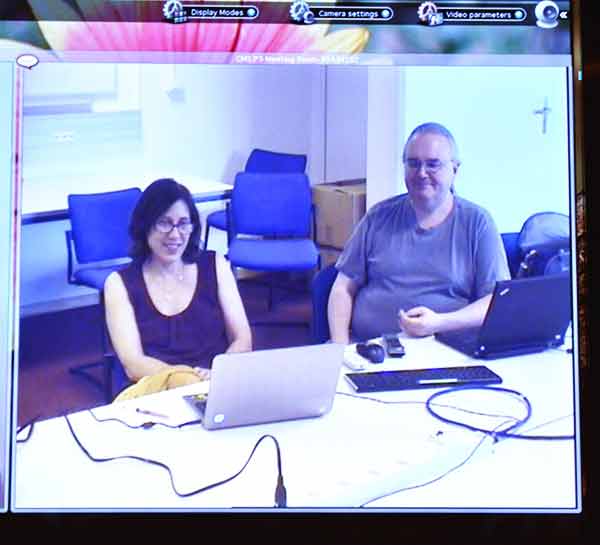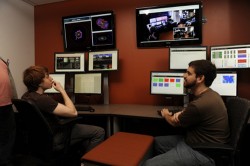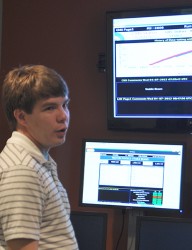
“Humanity has spent the last 4,000 years trying to figure out how the universe works. There have only been a few times when we’ve made a major leap forward, and this is one of those times.”
That is how Robert Scherrer, chairman of the physics department, explained the significance of the announcement that an international team of scientists working at the world’s largest atom smasher, the Large Hadron Collider, made in the wee hours of the morning of July 4.

Two groups of experimenters working at the LHC reported from Geneva that they had clear evidence for the existence of a new subatomic particle and this particle has some of the basic properties predicted for the Higgs boson. The long-sought particle is the final missing ingredient in the standard model, the general framework that physicists have developed to explain the behavior of all the known sub-atomic particles. In particular, it is associated with a field thought to endow elementary particles with mass.
Scherrer wasn’t involved in the discovery, but Vanderbilt has a small group of physicists and students who are members of one of the two experiments – the Compact Muon Solenoid (CMS) detector – that made the announcement at 2 a.m. Nashville time.

Two of them – Professor Julia Velkovska and Associate Professor Will Johns – were in Geneva at the headquarters of CERN, the European research center that operates the LHC, and another two, Professors Paul Sheldon and Charles Maguire, were in Nashville and stayed up all night to watch the videocast. The fifth member of the team, Professor Vicki Greene, was traveling. “I also stayed up all night to watch the videocast; I wasn’t going to miss the Higgsmania,” she emailed.
“The room was full and everybody was very excited,” said Velkovksa, who watched from one of the CERN conference rooms. “Our experiment went first. When our spokesman got to the point where he showed the data everyone stood up and applauded. I’ve never seen this before at a physics event.”
Velkovska added that the most satisfying part of the announcement for her was when the presenter for the other experiment displayed their data and it was clear that they independently had gotten the same results.
For Maguire, the emotional peak of the event was when the CMS spokesman put up the data on the screen. “[lquote]He put up one slide where it was very clear that the Higgs was there, and he showed this slide, and then he stopped speaking for about 10, 15 seconds, just gazing at it, because he was entranced by it.[/lquote] After 40 years of searching for this thing, there it stood, very prominent, no doubt about it, and it was just about the most thrilling moment of the whole presentation for me when he did that.”
The discovery of the illusive particle was a technological and scientific tour de force. According to the scientists, it was comparable to locating three specific grains in a swimming pool filled with sand. First they needed an atom smasher that was bigger and more expensive than a single nation could afford.
The LHC cost more than $6 billion to construct. To search for the Higgs, this gigantic instrument, which fills a ring-shaped tunnel 17 miles long, accelerates two beams of protons in opposite directions to speeds approaching 99.9999 percent of the speed of light and then smashes them together.
When these particles collide at these velocities, they create micro-explosions with temperatures 100,000 times hotter than the sun that produce showers of thousands to millions sub-atomic particles which rapidly decay into even more daughter particles.
Four different international teams of scientists designed and built four different detectors – each the size of a large house – that are placed around the LHC ring to record the sub-atomic detritus produced by these mini-bangs. Two of these detectors sorted and sifted the mountains of data that they produced looking for clues that Higgs particles were being created and then decaying into other more commonplace particles.

The Vanderbilt team has set up a virtual control room that allows them to monitor the operation of the CMS detector and alert the operators if they see any problems in the detector subsystems. The detector produces such a flood of data that no one center has the capacity to handle. So the scientists split the data down into more than a dozen different streams that go to different locations, including Vanderbilt, where they undergo preliminary analysis.
The CERN home page promotes the new discovery with the headline, “Higgs within reach: Our understanding of the universe is about the change …”

As the ellipsis implies, no one knows what the implications will be. In part this will depend on exactly what the properties of the new particle are, something that will take another two or three years of atom smashing and data crunching. “There are some hints that this may not be exactly like the Higgs particle predicted by the Standard Model,” Sheldon said. “If there are differences then it means there is new physics. For example, they could give us some important clues about the nature of dark matter.”
Dark matter is a type of matter that cannot be seen directly by telescopes. Its existence has been postulated based on the gravitational influence it exerts on normal matter seen in the rotation of stars within galaxies and in the interaction between galaxies. It is estimated that 84 percent of the matter in the universe is dark matter. The additional discovery of dark energy – a mysterious force that is driving the expansion of the universe – means that physicists know very little about the basic nature of 96 percent of matter and energy in the universe.
“We know there is dark energy and dark matter, but what we understand is only 4 percent of what’s out there,” said Maguire. “That’s embarrassing. If we can figure out what dark matter is, that’s about 23 percent, which would make us feel a lot better.”
Similarly, any practical applications are decades in the future, but they could be substantial. Sheldon pointed out that 100 years ago, when physicists were developing the basic rules that govern the atomic world, called quantum mechanics, there were no immediate applications. Today, however, many of our new devices such as computer chips, cell phones, accelerometers used in automobile air bags, lasers and solid state lights are based on the insights of quantum mechanics.
“Who knows what this will lead. But, oh boy, come back in 50 years!” Sheldon said.
Wednesday morning team members briefed the local media about the announcement:
WPLN News: Vandy Physicists Part of Celebration for Potential Higgs Boson